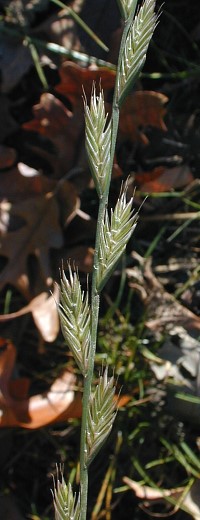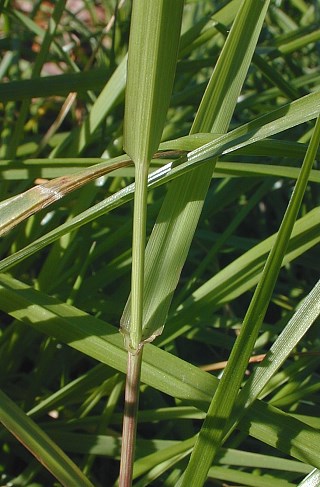 Description:
This grass is usually an annual, although sometimes it is a biennial or
short-lived perennial. It consists of a flowering culm with alternate
leaves about 1-3' tall. The culm is pale green, terete, glabrous, and
unbranched. The blades of the alternate leaves are up to 8" long and
1/3" (8 mm.) across; they are ascending to widely spreading, linear in
shape, and rather floppy. The blades are medium green on both sides,
shiny, and hairless; the base of each blade is wider than the sheath or
the culm, around which there extends a pair of auricles. The leaf
sheaths are pale green to pale reddish green, hairless, and
longitudinally veined. At the apex of the culm, there develops a floral
spike about 6-10" long, consisting of alternate spikelets along the
rachis (flowering stalk). These spikelets are located edgewise along
the rachis. The culm often undulates from one spikelet to the next.
Each spikelet consists of a single outer glume and 8-20 lemmas with
florets. In each spikelet, the ascending lemmas are arranged in 2
overlapping ranks. The glume (8-12 mm. in length) is longer than the
lemmas, but shorter than length of the spikelet; it is linear-elliptic,
convex along its outer surface, where there are 3-5 longitudinal veins.
Each lemma is 6-8 mm. in length, linear-elliptic, and convex along its
outer surface, where there are several longitudinal veins. The upper
lemmas have awns (shorter than the length of the lemmas), while the
lower lemmas frequently lack awns. Each lemma has a single floret with
an ovary, 3 stamens, and a pair of feathery stigmata. The blooming
period can occur from late spring to fall, but lasts only 2 weeks. The
florets are wind-pollinated. Each fertile floret is replaced by an
elongated grain. The root system is fibrous. This grass spreads by
reseeding itself.
Description:
This grass is usually an annual, although sometimes it is a biennial or
short-lived perennial. It consists of a flowering culm with alternate
leaves about 1-3' tall. The culm is pale green, terete, glabrous, and
unbranched. The blades of the alternate leaves are up to 8" long and
1/3" (8 mm.) across; they are ascending to widely spreading, linear in
shape, and rather floppy. The blades are medium green on both sides,
shiny, and hairless; the base of each blade is wider than the sheath or
the culm, around which there extends a pair of auricles. The leaf
sheaths are pale green to pale reddish green, hairless, and
longitudinally veined. At the apex of the culm, there develops a floral
spike about 6-10" long, consisting of alternate spikelets along the
rachis (flowering stalk). These spikelets are located edgewise along
the rachis. The culm often undulates from one spikelet to the next.
Each spikelet consists of a single outer glume and 8-20 lemmas with
florets. In each spikelet, the ascending lemmas are arranged in 2
overlapping ranks. The glume (8-12 mm. in length) is longer than the
lemmas, but shorter than length of the spikelet; it is linear-elliptic,
convex along its outer surface, where there are 3-5 longitudinal veins.
Each lemma is 6-8 mm. in length, linear-elliptic, and convex along its
outer surface, where there are several longitudinal veins. The upper
lemmas have awns (shorter than the length of the lemmas), while the
lower lemmas frequently lack awns. Each lemma has a single floret with
an ovary, 3 stamens, and a pair of feathery stigmata. The blooming
period can occur from late spring to fall, but lasts only 2 weeks. The
florets are wind-pollinated. Each fertile floret is replaced by an
elongated grain. The root system is fibrous. This grass spreads by
reseeding itself.
Cultivation:
The preference is full or partial sun, moist to dry-mesic conditions,
and fertile loam, although other kinds of soil are tolerated. Growth
and development are rapid, but this grass is short-lived.
Range & Habitat:
Italian Rye Grass is scattered across Illinois, where it is uncommon to
occasional (see Distribution
Map). This non-native grass was introduced into North America
from Europe. Naturalized habitats include disturbed meadows, roadsides,
fields, and waste areas. This grass usually doesn't persist in such
habitats. It is still cultivated as a source of quick vegetative cover
where the ground has been exposed by various development projects. It
is also used as a source of forage, particularly in the southern states.
Faunal Associations:
Insects that feed on Italian Rye Grass include the flea beetle Chaetocnema
pulicaria, Rhopalosiphum padi (Bird
Cherry / Oat Aphid), Nephelodes minians (Bronzed
Cutworm), and Pediasia trisecta (Larger Sod Worm).
Cattle, sheep, and other domesticated farm animals readily graze on the
foliage, particularly while it is still young and immature. When this
grass is planted near bodies of water, Canada Geese also like to feed
on the foliage.

Photographic
Location:
A roadside bank in Urbana, Illinois, where this grass was planted
deliberately for erosion-control.
Comments:
As a result of the alternating spikelets, the floral spikes of Lolium
spp. (Rye Grasses) have a distinctive appearance. These
grasses are unusual in having only one glume per spikelet, instead of
two. There are two other species in this genus that have naturalized in
Illinois. Italian Rye Grass can be distinguished from Lolium
perenne (English Rye Grass) by the more numerous lemmas in
its spikelets (8 or more), which are frequently awned. It also differs
from another species, Lolium tremulentum (Darnel),
by having glumes that are shorter than spikelets. Another scientific
name of Italian Rye Grass is Lolium perenne multiflorum.